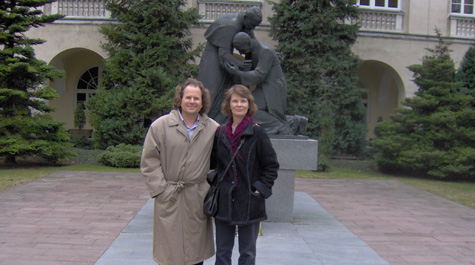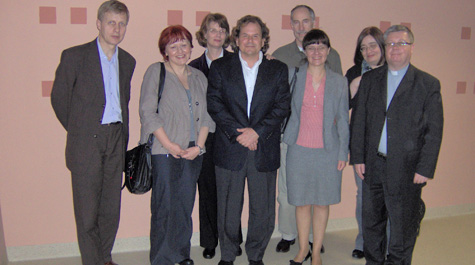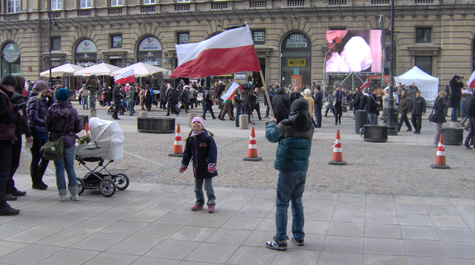Joy, history weave 'intense' trip to Poland
Intensely political.
Intensely scholarly.
Intensely personal.
Intensely emotional.
While on academic leave from William & Mary, they had been invited by the Catholic University in Lublin, Poland, to present their papers on joy.
The John Paul II Institute originally contacted Adam Potkay, asking for permission to translate his work into Polish for their journal “Ethos.” They printed two of his articles. Since he could use his Plumeri Award for Faculty Excellence funds to pay for his own airfare, he offered to visit as a speaker.
“Then, they discovered on their own that my wife Monica, who teaches at the College, also is an academic who specializes in the Middle Ages, and they said, ‘we love the Middle Ages and we would love it if she could come and say something about joy in the middle ages because the communists didn’t let us study the Middle Ages,” he said.
The institute then planned a seminar about joy based on their work.
“We gave papers that worked very well together because [Adam Potkay was] largely talking about classical and Protestant traditions of joy and I filled in the middle about what happened to theories of joy in the Middle Ages,” she said.
They described being overwhelmed by the academic intensity. About 30 to 40 professors, graduate students, and undergraduate students attended the talk. According to Monica Potkay, some of those who attended specialized in the same periods as she and Adam Potkay, in the Middle Ages and 18th and 19th century. There were also classicists, specialists in the Romance languages and in English.
The institute had translated their talks into Polish and distributed them ahead of time.
“So, it was scholarly intense in that people had really read our stuff in advance and were really prepared during the day of the seminary to talk about it intensively for hours,” Adam Potkay said.
Monica Potkay contrasted that level of preparedness with how seminars usually are.
“Ordinarily, when you give a paper, when you give a seminar, people come, but it’s surprising for any academic audience to be that well-prepared, to have read your things and it was very, very impressive and it was an honor to be treated so seriously,” she said.
Since Adam and Monica Potkay are both ethnically Polish, this trip also had personal significance even before their seminar presentation.
“We always talked about going together - I’d been there before, he had not - since that’s where our families come from,” Monica Potkay said.
They started in Krakow, one of the oldest cities in Poland, which, according to Monica Potkay, is “well-preserved from the Middle Ages.”
“The weight of history everywhere is just crushing and Poland has an unhappy history not just in the 20th century but in the 18th and 19th,” she said.
Krakow has restored an old Jewish quarter, one of very few remaining in central Europe, “but there are very few Jews left in it,” said Adam Potkay.
“It was the Nazi plan that once European Jewry was entirely extinguished, that this one Jewish quarter in Krakow would be a museum of Jewry,” he explained. “That’s intense.”
From Krakow, they went to Lublin by train, where the seminar was held. The moment they arrived at Lublin, they were greeted by people from the Catholic University in Lublin.
“It was intense because they really wanted to show us around,” Adam Potkay said. “They wanted to be with us at all times. They were at the train, they wanted to take our bags. I said ‘No, I’ll carry it’ - ’No, you cannot carry it.’ They were taking us here and there. If you said ‘I like that picture, ‘We will buy you a reproduction’ - ‘No, no, no’ - ‘Yes, we will.’”
According to Monica Potkay, this is customary of the highly formal and traditional Polish society.
“My grandparents are from Poland, [and] I grew up in the Polish community in Chicago, so I feel like I’ve kind of grown up in the culture,” she said. “And, I know it’s very formal and very hospitable, but still I was overwhelmed by the level of hospitality.”
The weight of Poland’s history was palpable in Lublin as well. The Catholic University in Lublin had been the only university with any autonomy during the Soviet era. Karol Wojtyla, who went on to become Pope John Paul II, had taught theology and ethics.
A Nazi concentration camp, Majdanek, was right outside of town.
“Lublin was after World War I, a majority Jewish city,” Adam Potkay explained. “But of course, all the Jews got displaced or killed.”
The city’s memory also included brutal years under Russia during the 19th century, when everyone was forced to undergo “Russification.”
“They would say ‘This is where the Russians put an orthodox church. We ripped this down stone by stone in 1919’,” Adam Potkay said. “‘This is where the statue of Lenin was. We tore this down in 1919. This is where the statue of Stalin was. We tore this down.’”
On their next stop, the Polish capital Warsaw, they saw the modern vestiges of Poland’s complicated relationship with Russia. Outside their hotel, which was next door to the presidential palace, hundreds of thousands of Poles gathered to commemorate the one-year anniversary of the Smolensk plane crash, in which nearly 100 members of the Polish government, including the president, were killed.
The plane crashed when the Polish government was going to Russia to commemorate the Katyn forest massacre in 1940, when nearly 22,000 members of the Polish army and intelligence were executed within two months.
“And for the whole Soviet era, they said ’No, we didn’t do this,’ and they finally admit it, ‘okay we did this,’” Adam Potkay said, “so [the Polish government was] going over to - and then the whole plane crashes on the way down, so, it’s ‘Oh god!’”
The country has changed significantly since the fall of the Soviet Union. Monica Potkay, who visited Poland in 1979, when it was still under the Communist regime, was struck by the changes.
“I was kind of shocked to see as many Pizza Huts and Subways as there were,” she said. “We had some of the best Chinese food in Warsaw, in a restaurant run by Chinese people and they were offering Chinese classes. It’s very international. When we were there, we went on a walking tour, there were tourists from Spain, from Turkey, from Korea, South America.”
Adam Potkay found the country, which he described as having an “old world elegance,” “more affluent, better reconstructed and prettier” than he had expected.
“When you come in from the airport from Warsaw, as you drive into town, along the outskirts of town you see the old Soviet-era construction,” he said. “Boy, it looks nasty. It’s full of nasty old fifties Soviet-era brutalist-style housing. But then, once you get into town, they rebuilt so much of it, and tried to restore it to some of its pre-World War II glory. There was more stuff restored and more stuff polished up than I’d imagined.
“After all that intensity and the heaviness of history you feel there, the lightness of being in the States really comes to the fore,” he said. “There is history [in the United States], but not like this. Not like, there was this city that was half-Jewish till not that long ago.”


















